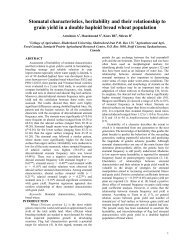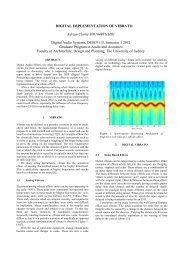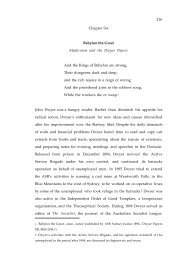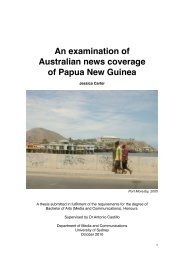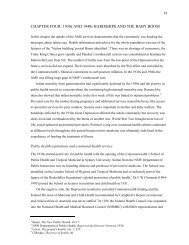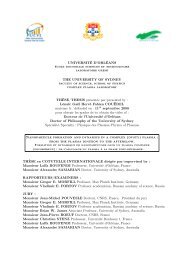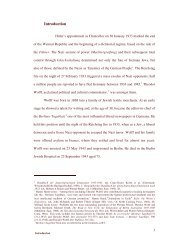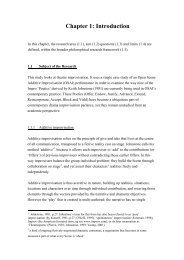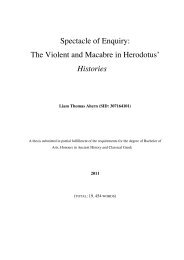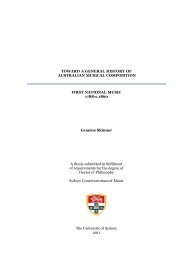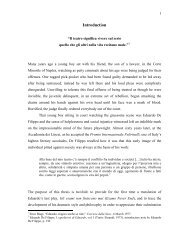journal of digital research & publishing - The Sydney eScholarship ...
journal of digital research & publishing - The Sydney eScholarship ...
journal of digital research & publishing - The Sydney eScholarship ...
You also want an ePaper? Increase the reach of your titles
YUMPU automatically turns print PDFs into web optimized ePapers that Google loves.
1 P M J O U R N A L O F D I G I T A L R ESEARCH & P UBLISHING<br />
spaces for the negotiation <strong>of</strong> their alternative identities.<br />
It is important to investigate the ways in which identity construction has become<br />
increasingly complex. Online identity negotiation is <strong>of</strong>ten located directly through the<br />
discourse <strong>of</strong> online communication; that is, through language use and social networking<br />
(Thiel 2005). So do online interactions lead to the formation <strong>of</strong> a distinctive online identity<br />
6+36& 039& 7>& 039& "76& )%& 8$DD%>%"6& D>70& 3"& $"8$I$8(3#L*& 7DC$"%& $8%"6$69p& B+$*& h(%*6$7"&<br />
3**(0%*&3&X57>%L&$8%"6$69&6+36&$*&36&788*&G$6+&6+$*&3>6$5#%L*&8%4"$6$7"&7D&$8%"6$69&3*&0(#6$'#%&<br />
3"8& C($8M& 5+& +3*& *+7G"& 6+36& >36+%>& 6+3"& 387'6$",& 3& 8$DD%>%"6& $8%"6$69& 7"#$"%S& $6&<br />
is sometimes the only place female adolescents feel comfortable expressing their ‘true’<br />
identity (Thiel 2005, p. 185). One reason may be that female adolescents who are confused<br />
or negotiating identity do not feel pressured to conform to a single or particular identity on<br />
6+%&$"6%>"%6M&B+$*&3>6$5#%&$*&*'%5$453##9&57"5%>"%8&G$6+&6+%*%&387#%*5%"6*&G+7&3>%&3#*7&D3"*M<br />
Fandom, Fan Fiction, and Identity<br />
A ‘fan’ is an individual with an intense liking and enthusiasm for a certain thing, called<br />
a ‘fanobject’ (Napier 2007). This fanobject can be anything: books, television series, or<br />
stars. Fans are distinguishable from other consumers by their level <strong>of</strong> emotional investment<br />
G$6+&6+%&D3"]7)R%56&.A3"8I7**&V;;r1M&B+$*&3>6$5#%&$*&57"5%>"%8&G$6+&3&*'%5$45&69'%&7D&D3"&t&<br />
0%8$3&D3"*M&N%8$3&D3"*&57"*6>(56&5(#6(>3#&3"8&*75$3#&$8%"6$69&)9&X)7>>7G$",&3"8&$"C%56$",&<br />
mass culture images’ (Jenkins 1992, p. 23). While some media fans stay committed to<br />
a star, others use individual series as springboards into broader fan subcultures, called<br />
‘fandoms’. A fandom’s existence represents a critique <strong>of</strong> conventional forms <strong>of</strong> consumer<br />
culture and provides a space where fans can discuss issues concerning sexuality, gender,<br />
racism, and forced conformity. Many fans feel greater freedom to express themselves and<br />
ask questions within fandoms, than outside them. Community is important: for many fans<br />
G+7&+3I%&"76&>%5%$I%8&4"3"5$3#&7>&5(#6(>3#&>%G3>8*&$"&,%"%>3#&*75$%69S&'>3$*%&D>70&6+%&D3"&<br />
community means a lot (Gregson 2005).<br />
‘Fan reading’ is a social process during which individual fans’ interpretations are<br />
shaped and reinforced through ongoing discussion with other fans (Jenkins 1992). <strong>The</strong>se<br />
discussions produce meanings that are more fully integrated with the fans’ lives. <strong>The</strong>se<br />
‘poached’ meanings shape how fans perceive future encounters with the fanobject (Jenkins<br />
1992). <strong>The</strong>re is empowerment in how fans assimilate fanobjects into their lives, and many<br />
D3"*&*+3>%&H"7G#%8,%&G$6+&76+%>*&)9&5>%36$",&D3"]6%P6*M&23"]6%P6*&$"5#(8%&D3"&456$7"S&D3"&<br />
art, and fan videos, and are shaped by the social norms and aesthetic conventions <strong>of</strong> the<br />
41






